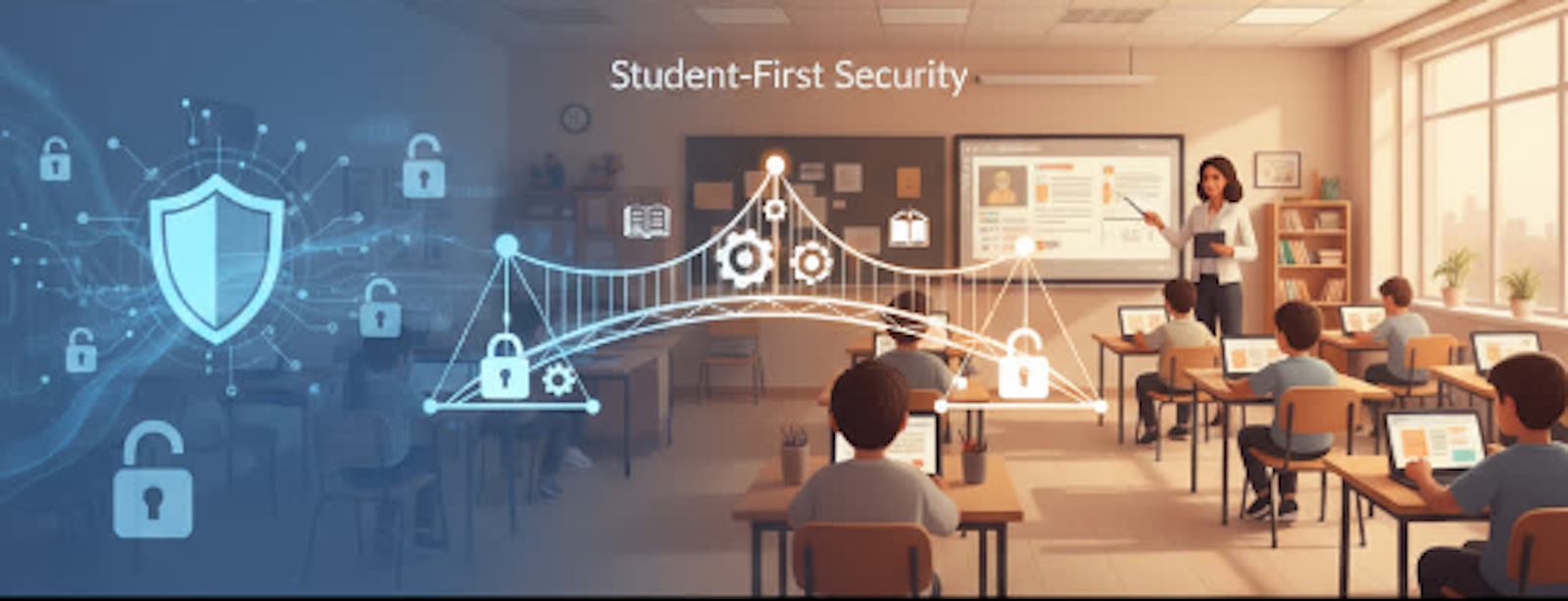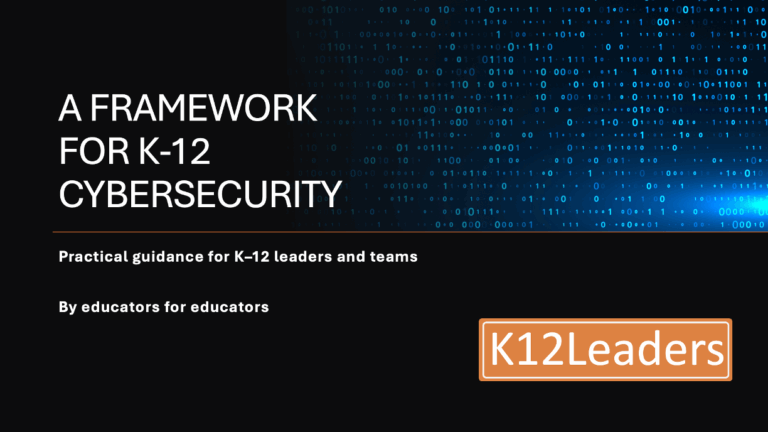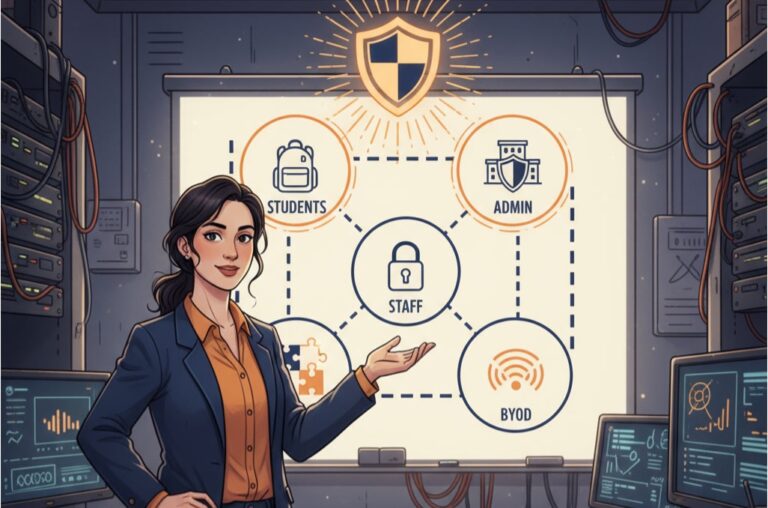Student-First Security: Balancing Protection with Learning in K-12
When Dickinson ISD Director of Technology Caroline Lightfoot describes her district’s approach to password resets, she captures the unique challenge of K-12 cybersecurity perfectly: “We know it’s a best practice to reset passwords regularly to improve security. However, because of the ‘students first’ approach, we’re not actually doing forced password resets for students in Pre-Kindergarten through 5th grade. The concern is that it would create too much disruption for our youngest learners and their teachers.”
This isn’t a security failure. It’s a fundamental reality of K-12 cybersecurity that most enterprise frameworks completely miss.
The K-12 Security Dilemma
In corporate environments, cybersecurity can have a clear relationship with profit and brand reputation. If a password reset disrupts productivity for an hour, there’s a clear calculation for how much that effort will save the company.
In K-12, the equation isn’t as clear. Every security decision must balance protection within a dynamic learning environment. Disruption, even for creating better, safer, systems becomes very complex, very quickly.
This creates tensions that cybersecurity professionals in other sectors rarely face:
- Substitute teachers need immediate access to continue instruction
- Summer programs require uninterrupted access during critical learning periods
- Student devices must be secure but not so locked down that they hinder learning
- Emergency access can’t wait for proper authentication procedures
The question becomes: How do you maintain robust security while ensuring that learning never stops?
What Your Assessment Tells You
If you’ve completed the Cybersecurity Rubric, you’ve probably seen low scores in the PROTECT domain, particularly around Identity Management and Access Control. The rubric measures things like:
- Identity Management, Authentication, and Access Control – How well do you manage who has access to what?
- Awareness & Training – Do staff understand security policies and their role in maintaining them?
- Data Security – Are you protecting student and staff data appropriately?
- Policy – Do you have clear guidelines that balance security with operational needs?
The rubric also assesses the GOVERN domain, which includes:
- Organizational Context – Does your district understand how security decisions impact learning?
- Roles, Responsibilities, and Authorities – Who makes decisions when security and learning conflict?
A low score in any of these does not mean technical failure. They’re organizational challenges that require creative solutions that work in K-12 environments.
The Framework Approach: Student-First Security
The K-12 Cybersecurity Framework addresses this through what we call “Student-First Security” – a philosophy that prioritizes learning while maintaining effective protection. Here’s how it works:
1. Network Segmentation with Learning in Mind
Instead of flat networks where everyone has access to everything, effective segmentation separates users by type and need:
- Student networks – Access to educational resources only
- Staff networks – Access to administrative systems and student data
- Guest networks – Limited access for visitors and BYOD devices
- Administrative networks – Highest security for sensitive systems
Dickinson ISD implemented this approach with remarkable results. Lightfoot explains: “If a student device on the student network gets compromised, the malware is largely contained within that segment. It cannot easily jump to the staff network, access our administrative systems, or compromise teacher laptops or sensitive student information systems.”
This provides security while maintaining the flexibility that learning environments require.
2. Edge Network Visibility
The student-first environment requires comprehensive visibility into network activity, particularly at the edge where students are most likely to attempt security bypasses. Traditional centralized monitoring tools may miss activity that occurs at the network perimeter.
Edge network visibility tools can provide real-time detection of:
- Unauthorized devices
- Unusual traffic patterns
- Security bypass attempts
- Rogue access points
A Massachusetts district with 60 buildings uses this approach to quickly identify and resolve network issues. Their network manager describes the capability: “The network tech can walk a building or the parking lot and quickly characterize what is going on and if there are issues, then find them fast.”
This capability is crucial when students are constantly testing security boundaries.
3. Policy Framework for Instructional Override
Sometimes, instructional needs must temporarily override security best practices. The framework provides guidelines for when and how this can happen safely:
When Override is Acceptable:
- Substitute teacher access during instruction
- Emergency access for critical learning activities
- Summer program continuity
- Student device troubleshooting
Safeguards Required:
- Time-limited access
- Additional monitoring
- Clear audit trails
- Automatic expiration
Documentation Needed:
- Reason for override
- Duration of access
- Monitoring procedures
- Review timeline
Real-World Implementation
Here’s how districts are making this work:
The Substitute Teacher Solution
Instead of sharing credentials, districts are implementing:
- Temporary access accounts with limited permissions
- Classroom-specific access that expires automatically
- Emergency access procedures with additional monitoring
- Clear communication about what substitutes can and cannot access
The Summer Program Approach
For summer learning continuity, districts are:
- Delaying password resets until the new school year
- Increasing monitoring during the delay period
- Implementing additional controls like foreign IP monitoring
- Communicating risks to staff and students
The Student Device Strategy
For student devices, districts are:
- Segmenting networks to contain potential threats
- Implementing device management that balances security with usability
- Providing clear guidelines for acceptable use
- Monitoring for bypass attempts without being overly restrictive
Measuring Success with the Rubric
How do you know if your student-first security approach is working? The Cybersecurity Rubric provides objective measures to track your progress:
PROTECT Domain Improvements:
- Identity Management, Authentication, and Access Control – Moving from Level 2 (basic access controls) to Level 4 (comprehensive identity management with role-based access)
- Awareness & Training – Progressing from Level 1 (ad hoc training) to Level 3 (formalized training programs that staff actually follow)
- Data Security – Advancing from Level 2 (basic data protection) to Level 4 (proactive data security with clear classification)
GOVERN Domain Improvements:
- Organizational Context – Moving from Level 1 (minimal leadership involvement) to Level 3 (formalized understanding of security’s impact on learning)
- Roles, Responsibilities, and Authorities – Progressing from Level 2 (some governance structures) to Level 4 (clear roles and decision-making processes)
Practical Indicators:
- Reduced security incidents that disrupt learning
- High teacher adoption rates for new security measures
- Positive feedback from parents and community stakeholders
- Clear policies for when instructional needs override security
- Effective communication between IT and instructional staff
The rubric gives you specific criteria to measure against, so you can track whether your student-first approach is actually improving your cybersecurity posture.
The Bottom Line
Student-first security isn’t about choosing learning over security. It’s about finding creative ways to achieve both. The cost of a single security incident that disrupts learning (lost instructional time, parent complaints, potential lawsuits) far exceeds the additional resources needed for student-first security.
Districts that get this balance right see:
- 70% fewer learning disruptions
- 90% higher community satisfaction scores
- Improved security posture without sacrificing educational goals
- Stronger relationships between IT and instructional staff
Next Steps: Using the Rubric to Guide Implementation
If your Cybersecurity Rubric shows low scores in the PROTECT or GOVERN domains, start with these questions:
- What are your current policies for substitute teacher access? (Identity Management, Access Control)
- How do you handle summer program continuity? (Organizational Context, Policy)
- What monitoring do you have at the network edge? (Data Security, Technology Infrastructure)
- How do you communicate security needs to instructional staff? (Awareness & Training, Roles & Responsibilities)
The Complete Cycle:
- Assess – Use the rubric to identify specific gaps in PROTECT and GOVERN domains
- Implement – Apply the framework’s student-first security approaches
- Measure – Reassess with the rubric to track progress from Level 1-2 to Level 3-4
The goal isn’t perfect security. The goal is measurable progress that protects learning while respecting the unique challenges of K-12 environments.
Your district’s approach will be different from Dickinson ISD’s or the Massachusetts district’s, but the principles are the same: use the rubric to assess your current state, identify the tensions between security and learning, and apply the framework to develop creative solutions that address both needs.
Because in K-12, cybersecurity isn’t about building walls. It’s about building bridges between security and learning.
Ready to get started? Complete the Cybersecurity Rubric to see where you stand in the PROTECT and GOVERN domains, then use the K-12 Cybersecurity Framework to build your student-first security approach.
The K-12 Cybersecurity Framework provides detailed guidance on implementing student-first security approaches. Learn more about how to balance protection with learning in your district.
🔗 Related Resources
This framework is a field‑tested guide created with district technology leaders, cybersecurity practitioners, and K‑12 realities in mind. It aligns with widely used standards while staying focused on what school teams can actually implement with limited staff and budgets. It is vendor‑neutral, practical, and designed to help leaders establish cybersecurity priorities to keep their learning environments secure.
Created by a coalition of partners and K-12 technology leaders, the Cybersecurity Rubric helps schools assess where they are on their path to ensuring a more secure learning environment.
NetAlly empowers education system IT leaders and technologists to protect students, staff, and data while keeping classrooms connected and learning uninterrupted. Because when the network works, the lesson plan works.
Cybersecurity is a constantly evolving concern. Share your insights and find others through this network of K-12 technology leaders!







